How to Do Nothing with Nobody All Alone by Yourself (4 page)
Read How to Do Nothing with Nobody All Alone by Yourself Online
Authors: Robert Paul Smith

BOOK: How to Do Nothing with Nobody All Alone by Yourself
11.33Mb size Format: txt, pdf, ePub
Okay, that's it about knives. Now, let's say you have the knife and you know how to use it, and you have a pencil.
One of the things we did was to cut a thin strip at the top of the pencil. Then we took a pen and wrote our names or initials on it, very small, like this. I know that you can get pencils with your names stamped on them, but we didn't have them then, and somehow it's different when you do it yourself.
HTDN_29a

Another thing we did was to decorate our pencils by cutting. Take one of the hexagonal pencils (hexagonal means six-sided, as a square is four-sided). These are usually painted yellow. Now, cut a very thin sliver, like this, so you've lifted off a little square of paint. Now on the side of the pencil right next to the side you've cut, cut another little square of paint that you can sliver off. Now the next side, and so on all around the pencil, making a checkerboard effect.
HTDN_29b
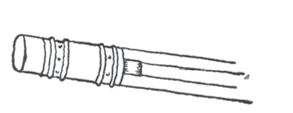
HTDN_30a
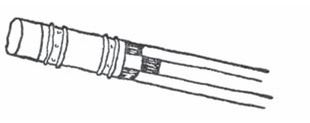
HTDN_30b
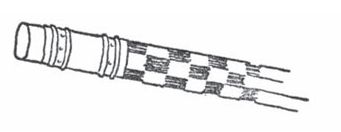
Working the same way, sort of, you can make a spiral all down the pencil. Or maybe you have some ideas of your own.
By the way, in the spring and summer when you can find a green branch of some kind, you can do all these things and many more with the branch. You cut very lightly, just enough to cut through the dark bark, and when you peel that off, you see just about the whitest white you'll ever see. We used to make walking sticks out of these branches, but we never really used them for walking. It was just to make designs in the bark.
If you can find a willow tree in the spring, you can make a whistle out of a willow branch, but you'll have to get a book from the library telling you how, because I never could make one.
One of the things I found out when I was writing this book was that an artist can't draw a picture of something without seeing it. I talked my wife into doing the drawings, and I've spent about a month now in making all the things in the book so that she could draw them. Fortunately for me, I was doing this in the fall, and I could tell her that the reason I couldn't make a willow whistle was because the only time to make willow whistles was in the spring. If you want the real truth, I never even
knew
a kid
who could make a willow whistle. But there were books in the library that told how to make a willow whistle, and I used to try. The only reason I'm even mentioning it is that people I've talked to claimed they knew a kid when they were kids who was able to make willow whistles. Maybe I'm just a dope about willow whistles and you'll be very good at making them. But everything else in the book I've made. I made them when I was a kid, and I made them again as a grownup, and they work. This is a guarantee.
knew
a kid
who could make a willow whistle. But there were books in the library that told how to make a willow whistle, and I used to try. The only reason I'm even mentioning it is that people I've talked to claimed they knew a kid when they were kids who was able to make willow whistles. Maybe I'm just a dope about willow whistles and you'll be very good at making them. But everything else in the book I've made. I made them when I was a kid, and I made them again as a grownup, and they work. This is a guarantee.
If you don't know what a willow tree looks like, go to the public library and get out a book about trees. You'll notice that all through this book, I advise you to go to the library when you want to find out something. I think just plain going to the library and getting out a book is a swell thing to do. It's something to do, when you've got nothing to do, all by yourself. It's a thing I still do when I've got nothing special to do. I just wander around until I find a book that looks interesting; let's say, a book about ship-building, or rockets, or a story by some author I've never heard of before. Now, chances are I'll never build a ship, or ride in a rocket, and maybe I won't like the way the author I never heard of writes. But it's interesting to know how someone else builds a ship, or plans to fly in a rocket, or how the author feels about things.
Now, as long as we're talking about knives, let's talk about mumbly-peg. This is a game you can play any time of the year it's not too cold or too wet to sit on the groundâwhich means it's really okay for any time except when there's two feet of snow or a flood.
This is the game you play with a Boy Scout knife. There's a long thin blade in it with a ridge along one side.
HTDN_32

The blade is called an awl, and it's made for punching holes in leather and things, but when I was a kid, that blade was a mumbly-peg blade. Your father may have called it something elseâI kind of remember some kids who came from another town calling it munjigo-peg, but it's the same game. I'm sure, just the way it was called a different name in different places, it's probably played a little differently in different placesâbut here's the way we played.
Sit down on the ground. Open up that awl blade; hold the knife flat in your palm. The idea is to flip the knife up, so it goes and sticks in the ground.
That's the first thing in mumbly-peg. Learn to do this one first, and you'll get an idea of how the knife balances and how high to throw it, and how to get your hand and knee out of the way. It's supposed to stick in the ground, not in you. Incidentally, that's another reason for using that particular blade. You notice that the tip is rounded and it doesn't have a cutting edge on it. Also, playing mumbly-peg is not the best thing in the world for a knife blade, what with hitting pebbles and dirt, and this blade is not sharp to begin with, so it can't be dulled, and that ridge along the edge strengthens it, so it won't break the way a regular knife blade might.
HTDN_33
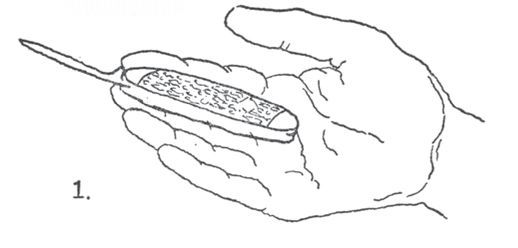
Now, if you're playing with another guy, you choose up to start. One of you flips the knife from the palm of the hand. If it sticks up right in the ground, that guy goes on to the second thing. If the knife doesn't stick, the other guy
gets a chance to flip it from his palm. If it sticks, he goes on to the second thing. If it doesn't, it goes back to you and you try and so on. This is the way it goes on all through the game, except for one thing which I'll tell you about in a minute.
gets a chance to flip it from his palm. If it sticks, he goes on to the second thing. If it doesn't, it goes back to you and you try and so on. This is the way it goes on all through the game, except for one thing which I'll tell you about in a minute.
The second thing in mumbly-peg is flipping the knife, same way, only from the back of the hand, like this:
HTDN_34
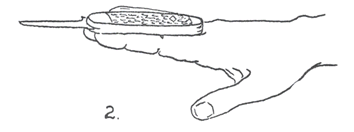
Now here's the thing I said I'd tell you in a minute. Suppose you have flipped it, and it stuck, from the palm. You go on to the second thing, the back of the hand. Suppose it doesn't stick when you flip it from the back. Then you have a choice. You can take a second chance doing it from the back. If it sticks, you go on. If it doesn't, the knife goes to the other guy,
and
when it comes back to you, you have to start at the beginning. This may not seem like much of
a gamble to you now, but wait until you've done ten things, and you have to make the choice between trying it again, or going all the way back ten things to the beginning.
and
when it comes back to you, you have to start at the beginning. This may not seem like much of
a gamble to you now, but wait until you've done ten things, and you have to make the choice between trying it again, or going all the way back ten things to the beginning.
I've been talking to people about mumbly-peg and some of them say that when they played you had to reach at least the high dive (that comes later) before you got a chance to riskâthat's what we called taking a second chance, we said we'd risk. Some other people say that they couldn't risk until they got to pennies, which comes later too, and still other people can't remember. I'm one of those other people: it seems to me the people who say you can't risk until the high dive are probably right. You can make your own rules about this.
Other books
Czech Mate by Sloane Taylor
Priceless by Olivia Darling
Craig's Heart by N. J. Walters
Chosen Thief by Scarlett Dawn
Under His Command by Annabel Wolfe
Tatiana March by Surrender to the Knight
A Difficult Boy by M. P. Barker
Jacob by Jacquelyn Frank
Hoops by Patricia McLinn
La Llorona by Marcela Serrano